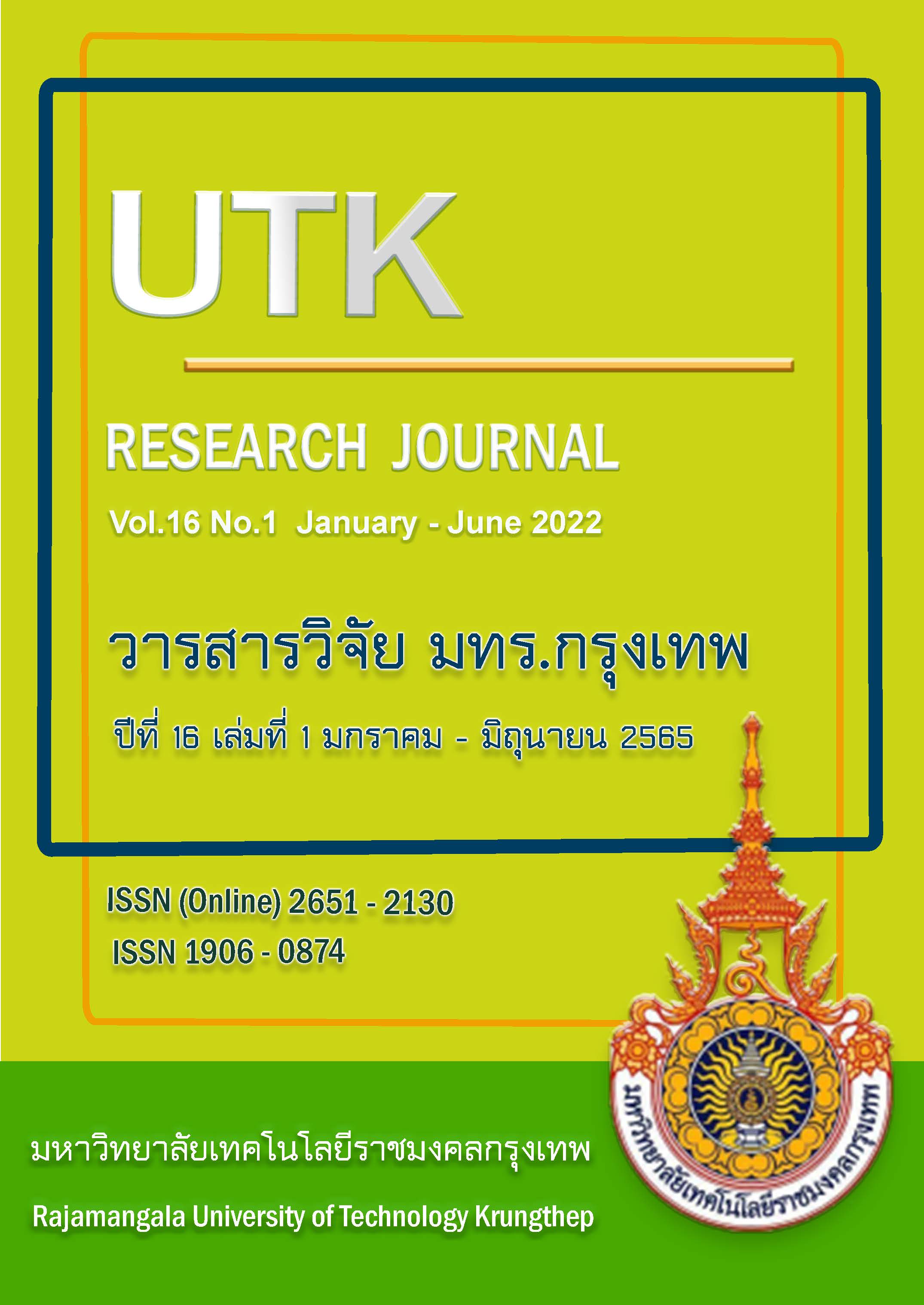Removal of Zinc Ions from Rubber Thread Wastewater using Chemical Precipitation Techniques
Keywords:
Zinc ion, Rubber thread wastewater, precipitationAbstract
The objective of this research was to remove zinc ions from rubber thread wastewater. The experiment was conducted by studying the optimum conditions of the precipitation process, i.e. the precipitant types (Sodium hydroxide, calcium hydroxide and sodium sulfide), amount of the precipitant, stirring time, settling time and comparison of zinc removal efficiency for each coagulant. The results showed that the optimum condition for the removal of zinc ions by the precipitation method was to use sodium sulfide at a concentration of 10% by weight/volume at a volume of 26.67 mL per 1 L of wastewater, fast stirring rate 100 rpm for 1 minute, slow stirring rate 30 rpm for 30 minutes and and the settling time for 60 minutes. The zinc content of water after treatment was 0.13 ± 0.05 mg/L, corresponding to 99.99 ± 0.03 % removal efficiency. Moreover, pH value 4.77 ± 0.01, conductivity 10.55 ± 0.06 µS/cm, COD 1,643.84 ± 91.32 mg/L. and suspended solids 4.50 ± 1.00 mg/L were obtained. The cost of wastewater treatment was 91.32 baht per cubic meter of wastewater.
References
Ahmed Basha C, Bhadrinarayana NS, Anantharaman N, Meera Sheriffa Begum KM. Heavy metal removal from copper smelting effluent using electrochemical cylindrical flow reactor. J Hazard Mater. 2008 Mar 21; 152(1):71–8.
Akbal F, Camcı S. Copper, chromium and nickel removal from metal plating wastewater by electrocoagulation. Desalination. 2011 Mar 15; 269(1–3):214–22.
Pohl A. Removal of heavy metal ions from water and wastewaters by sulfur-containing precipitation agents. Water Air Soil Pollut. 2020 Sep 28; 231(10):503.
Rodriguez-Freire L, Gonzalez-Estrella J, Li G. Technologies for fractionation of waste-
water and resource recovery. In 2020. p. 329–54.
Vishali S, Kavitha E. Chapter 6 - Application of membrane-based hybrid process on paint industry wastewater treatment. In: Shah MP, Rodriguez-Couto S, editors. Membrane-Based Hybrid Processes for Wastewater Treatment [Internet]. Elsevier; 2021 [cited 2021 Dec 15]. p. 97–117. Available from: https://www.sciencedirect.com/science/article/pii/B9780128238042000161
Ain Zainuddin N, Azwan Raja Mamat T, Imam Maarof H, Wahidah Puasa S, Rohana Mohd Yatim S. Removal of nickel, zinc and copper from plating process industrial raw effluent via hydroxide precipitation versus sulphide precipitation. IOP Conf Ser Mater Sci Eng. 2019 Aug 1; 551(1):012122.
Ayres DM, Davis AP, Gietka PM. Removing heavy metals from wastewater University of Maryland; 1994 Aug Available from: http://www.appliedmechtech.com/wp-content
Veeken AHM, Akoto L, Hulshoff Pol LW, Weijma J. Control of the sulfide (S2-) concentration for optimal zinc removal by sulfide precipitation in a continuously stirred tank reactor. Water Res. 2003 Sep; 37(15):3709–17.
U.S. EPA. Control and treatment technology for the metal finishing industry-sulfide precipitation. [Internet]. Cincinnati, Ohio: United States Environmental Protection Agency; 1980. Report No.: EPA 625/8-80-003. Available from: https://nepis.epa.gov/Exe/ZyNET.exe/30004EDD.TXT
Yrjas KP, Zevenhoven CAP, Hupa MM. Hydrogen sulfide capture by limestone and dolomite at elevated pressure. 1. sorbent performance. Ind Eng Chem Res. 1996 Jan 1; 35(1):176–83.
Junuzovic H, Begic S, Selimović A, Djozic A, Cvrk R, Ahmetović M. Efficiency of carbonate precipitation and removal of copper and nickel Ions from their mono-
component and two-component aqueous solutions. Int J Res Appl Sci Biotechnol. 2019 Dec 13;06:11–5.
Patterson JW, Allen HE, Scala JJ. Carbonate precipitation for heavy metals pollutants. J Water Pollut Control Fed U S Available from: https://www.osti.gov/biblio/5170276
มั่นสิน ตัณฑุลเวศม์. วิศวกรรมการประปา เล่ม 1. 3rd ed. กรุงเทพฯ.: สำนักพิมพ์แห่งจุฬาลงกรณ์มหาวิทยาลัย; 2542.
American public health association, eaton AD, American water works association, water environment federation. Standard methods for the examination of water and wastewater. Washington, D.C.: APHA-AWWA-WEF; 2005.
Platte JA, Marcy VM. Photometric Determination of Zinc with zincon. application to water containing heavy metals. Anal Chem. 1959 Jul 1;31(7):1226–8.
Säbel CE, Neureuther JM, Siemann S. A spectrophotometric method for the determination of zinc, copper, and cobalt ions in metalloproteins using Zincon. Anal Biochem. 2010 Feb 15; 397(2):218–26.
Faiz U, Butt T, Satti L, Hussain W, Hanif F. Efficacy of zinc as an antibacterial agent against enteric bacterial pathogens. J Ayub Med Coll Abbottabad JAMC. 2011 Jun; 23(2):18–21.
Sirelkhatim A, Mahmud S, Seeni A, Kaus NHM, Ann LC, Bakhori SKM, et al. Review on zinc oxide nanoparticles: antibacterial activity and toxicity mechanism. Nano-Micro Lett. 2015 Jul 1; 7(3):219–42.
Freeman HM. Standard handbook of hazardous waste treatment and disposal. 2 edition. New York: McGraw-Hill Education; 1997.
Cañizares P, Martínez F, Jiménez C, Sáez C, Rodrigo MA. Coagulation and electro
coagulation of oil-in-water emulsions. J Hazard Mater. 2008 Feb 28; 151(1): 44–51.
กระทรวงอุตสาหกรรม. ประกาศกระทรวงอุตสาหกรรม เรื่อง กำหนดมาตรฐานควบคุมการระบายน้ำทิ้งจากโรงงาน พ.ศ. 2560. ราชกิจจานุเบกษา เล่ม 134 ตอนพิเศษ 153 ง 2560, 15 หน้า.
Downloads
Published
How to Cite
Issue
Section
License
Copyright (c) 2022 UTK RESEARCH JOURNAL

This work is licensed under a Creative Commons Attribution-NonCommercial-NoDerivatives 4.0 International License.
กองบรรณาธิการวารสารวิชาการ มหาวิทยาลัยเทคโนโลยีราชมงคลกรุงเทพ มีความยินดีที่จะรับบทความจากอาจารย์ นักวิจัย นักวิชาการทั้งภายในและภายนอกมหาวิทยาลัย ในสาขาวิชาวิทยาศาสตร์และเทคโนโลยี ได้แก่ สาขาวิชาวิทยาศาสตร์ วิศวกรรมศาสตร์ และสาขาอื่นๆ ที่เกี่ยวข้อง รวมถึงสาขาต่างๆ ที่มีการบูรณาการข้ามศาสตร์ที่เกี่ยวข้องวิทยาศาสตร์และเทคโนโลยี ที่เขียนเป็นภาษาไทยหรือภาษาอังกฤษ ซึ่งผลงานวิชาการที่ส่งมาขอตีพิมพ์ต้องไม่เคยเผยแพร่ในสิ่งพิมพ์อื่นใดมาก่อน และต้องไม่อยู่ในระหว่างการพิจารณาของวารสารอื่น
การละเมิดลิขสิทธิ์ถือเป็นความรับผิดชอบของผู้ส่งบทความโดยตรง บทความที่ได้รับการตีพิมพ์ต้องผ่านการพิจารณากลั่นกรองคุณภาพจากผู้ทรงคุณวุฒิและได้รับความเห็นชอบจากกองบรรณาธิการ
ข้อความที่ปรากฏอยู่ในแต่ละบทความที่ตีพิมพ์ในวารสารวิชาการเล่มนี้ เป็นความคิดเห็นส่วนตัวของผู้เขียนแต่ละท่าน ไม่เกี่ยวข้องกับมหาวิทยาลัยเทคโนโลยีราชมงคลกรุงเทพแต่อย่างใด ความรับผิดชอบด้านเนื้อหาและการตรวจร่างบทความแต่ละบทความเป็นของผู้เขียนแต่ละท่าน หากมีความผิดพลาดใดๆ ผู้เขียนแต่ละท่านจะต้องรับผิดชอบบทความของตนเองแต่ผู้เดียว
กองบรรณาธิการขอสงวนสิทธิ์มิให้นำเนื้อหา หรือข้อคิดเห็นใดๆ ของบทความในวารสารวิชาการ มหาวิทยาลัยเทคโนโลยีราชมงคลกรุงเทพ ไปเผยแพร่ก่อนได้รับอนุญาตจากกองบรรณาธิการ อย่างเป็นลายลักษณ์อักษร ผลงานที่ได้รับการตีพิมพ์ถือเป็นลิขสิทธิ์ของวารสาร






